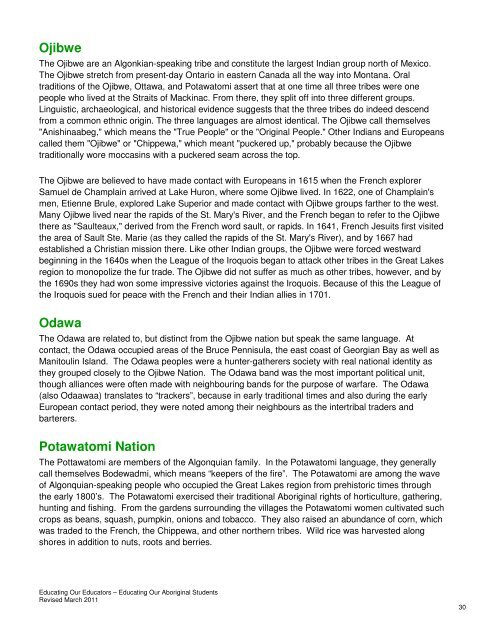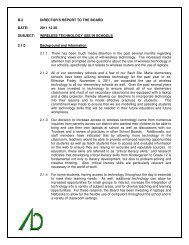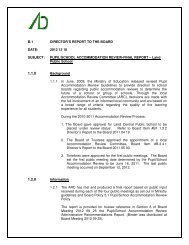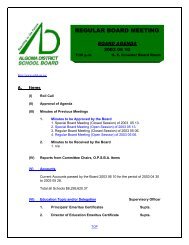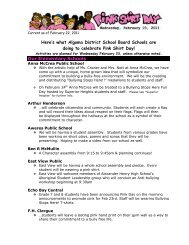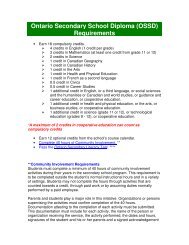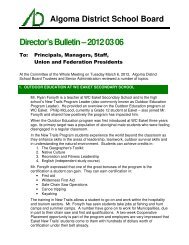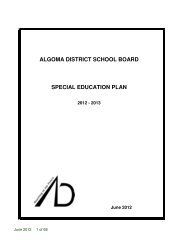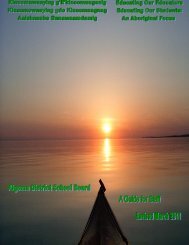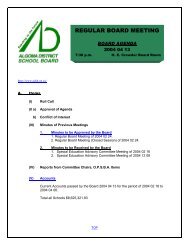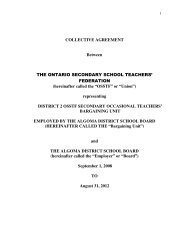Educating Our Educators Guide for Staff - Algoma District School ...
Educating Our Educators Guide for Staff - Algoma District School ...
Educating Our Educators Guide for Staff - Algoma District School ...
- No tags were found...
Create successful ePaper yourself
Turn your PDF publications into a flip-book with our unique Google optimized e-Paper software.
OjibweThe Ojibwe are an Algonkian-speaking tribe and constitute the largest Indian group north of Mexico.The Ojibwe stretch from present-day Ontario in eastern Canada all the way into Montana. Oraltraditions of the Ojibwe, Ottawa, and Potawatomi assert that at one time all three tribes were onepeople who lived at the Straits of Mackinac. From there, they split off into three different groups.Linguistic, archaeological, and historical evidence suggests that the three tribes do indeed descendfrom a common ethnic origin. The three languages are almost identical. The Ojibwe call themselves"Anishinaabeg," which means the "True People" or the "Original People." Other Indians and Europeanscalled them "Ojibwe" or "Chippewa," which meant "puckered up," probably because the Ojibwetraditionally wore moccasins with a puckered seam across the top.The Ojibwe are believed to have made contact with Europeans in 1615 when the French explorerSamuel de Champlain arrived at Lake Huron, where some Ojibwe lived. In 1622, one of Champlain'smen, Etienne Brule, explored Lake Superior and made contact with Ojibwe groups farther to the west.Many Ojibwe lived near the rapids of the St. Mary's River, and the French began to refer to the Ojibwethere as "Saulteaux," derived from the French word sault, or rapids. In 1641, French Jesuits first visitedthe area of Sault Ste. Marie (as they called the rapids of the St. Mary's River), and by 1667 hadestablished a Christian mission there. Like other Indian groups, the Ojibwe were <strong>for</strong>ced westwardbeginning in the 1640s when the League of the Iroquois began to attack other tribes in the Great Lakesregion to monopolize the fur trade. The Ojibwe did not suffer as much as other tribes, however, and bythe 1690s they had won some impressive victories against the Iroquois. Because of this the League ofthe Iroquois sued <strong>for</strong> peace with the French and their Indian allies in 1701.OdawaThe Odawa are related to, but distinct from the Ojibwe nation but speak the same language. Atcontact, the Odawa occupied areas of the Bruce Pennisula, the east coast of Georgian Bay as well asManitoulin Island. The Odawa peoples were a hunter-gatherers society with real national identity asthey grouped closely to the Ojibwe Nation. The Odawa band was the most important political unit,though alliances were often made with neighbouring bands <strong>for</strong> the purpose of warfare. The Odawa(also Odaawaa) translates to “trackers”, because in early traditional times and also during the earlyEuropean contact period, they were noted among their neighbours as the intertribal traders andbarterers.Potawatomi NationThe Pottawatomi are members of the Algonquian family. In the Potawatomi language, they generallycall themselves Bodewadmi, which means “keepers of the fire”. The Potawatomi are among the waveof Algonquian-speaking people who occupied the Great Lakes region from prehistoric times throughthe early 1800’s. The Potawatomi exercised their traditional Aboriginal rights of horticulture, gathering,hunting and fishing. From the gardens surrounding the villages the Potawatomi women cultivated suchcrops as beans, squash, pumpkin, onions and tobacco. They also raised an abundance of corn, whichwas traded to the French, the Chippewa, and other northern tribes. Wild rice was harvested alongshores in addition to nuts, roots and berries.<strong>Educating</strong> <strong>Our</strong> <strong>Educators</strong> – <strong>Educating</strong> <strong>Our</strong> Aboriginal StudentsRevised March 201130


